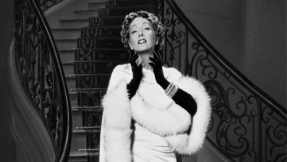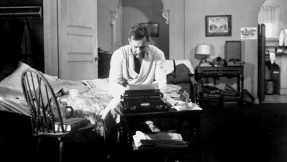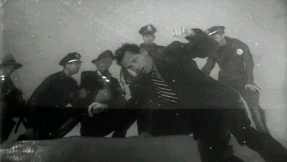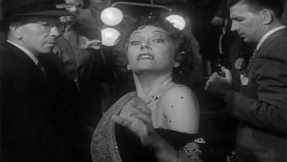Why Sunset Boulevard Still Captures the “Eyes of the World” Today

There is little question that Billy Wilder’s masterpiece Sunset Boulevard still captures the hearts, minds, and souls of audiences today, be they in their homes or Vaudeville style theatres, turned movie houses. Since its release in August of 1950, it has been the inspiration to countless films. But what does it mean to you? What makes it special or stand out to you? Perhaps you just see it as an iconic film; or just maybe, you see it as representing something personal to you. From classic noir cinematography to some of the most quoted lines of all time, Norma Desmond’s spirit lives on. So much for Joe Gillis’ line about her “still waving proudly to a parade that has long since passed her by;” she is still as alive today as she ever was. Serving as a mirror to the current state of Hollywood, Billy Wilder’s film shed light on the darker side of celebrity that still haunts to this very day. This timeless movie provoked Hollywood to take a cynical and honest look at itself, and the dangerous price of stardom–especially when the star is fading into obscurity. Poignantly arriving near the end of the Golden Era (or Studio System), this cinematic masterpiece will continue to be the epitome of a Hollywood and anti-Hollywood film for all eternity. Beyond what it meant historically or industry-wise, it holds meaning and significance for many who watch it. One of its strengths to withstand the test of time is the fact is its ability to connect with people visuals and emotionally. That, combined with solid technical aspects, makes for a dynamic cinema experience.
The Story
Part of what still beckons the “eyes of the world” is the movie’s ability to tell the story within a story. In many ways, Gloria Swanson truly is Norma Desmond. Swanson took a role that was essentially making a mockery of everything she once stood for. Like Norma Desmond, Swanson was one of Hollywood’s highest paid performers in the 1930s and staged a failed comeback in the 1940s, following “talkies.” The role was originally offered to Mae West and Mary Pickford, but no one could capture the character of Norma Desmond like Gloria Swanson. Throughout the movie, we witness the psychological breakdown of a woman who is already seriously afflicted with chronic depression and even agoraphobia. I feel as though many actors, and even some industry professionals who are not performers, can truly understand what must have been going through the mind of Norma Desmond. Actually, even for those who are not involved in entertainment or media can still see someone who felt betrayed and left alone to drift away. We’ve all been there. Feeling like we have so much to give the world, our community, or to the arts, and no one to take or acknowledge it. Norma isn’t going through anything that we have not been through. Essentially, Norma’s significant other, or partner, was her celluloid self, the studio, the industry. And when her partner left her, never to return, she developed serious psychological and cognitive disorders. Each person who chooses to watch her downward spiral into insanity, should be able to identify with her on some level regarding something in their life. For Norma, it was being back on screen again. For you, maybe it’s finding a romantic relationship.
Fascinating elements of this story include the bewildering world of what lies between the glory and the fall of a celebrity who feels as though she built Hollywood, more specifically Paramount Studios. Never before had there been a movie that was developed around the idea of what happens to a star after they are rejected by the very business that created them. Serving as the inspiration to the opening scene of American Beauty nearly 50 years prior, Wilder set the standard in the dead body of the protagonist narrating the film. Like the fog over London, Gillis’ spirit hovers over the entire movie, narrating the course of events that lead to his demise. Joe gets to do what any of us would enjoy doing–getting to observe what happens after we die and how everyone reacts. Just like having a soundtrack to your life would be amazing, getting to narrate your story after you die would be equally, if not more so, enamoring.

William (Bill) Holden’s character of Joe Gillis is the prime representation of a starving artist. He lives in a tiny apartment, has a few credits to his name and is in danger of having his car repossessed. That describes many artists today, thus allowing other aspiring screenwriters and filmmakers to identify with his frustrations. Like a true film noir, the ending is tragic for the protagonist. Part of the suspense is wondering just when will he meet his end and why. For those who are trying to make it in the industry as a screenwriter, the grief and depression Joe must been feeling is something with which aspiring screenwriters can empathize.
Sunset Boulevard contains something for everyone: elements of mystery, action, romance, and deceit are woven meticulously throughout the film. This allows for the story to transcend decades of movie evolution and maintain such a high regard in the minds of all the “people out there in the dark.” And, even land a spot on the Great White Way in Andrew Lloyd Webber’s Sunset Boulevard Broadway musical. It’s been rumored that Paramount plans to make a movie version of the Broadway show, but that rumor has been floating around Hollywood for years. As much as the the musical is a tribute to the original, the movie will always be more impactful because the stage simply cannot bring you as close to eyes of the actor as the screen can. And, Norma “can say anything with [her] eyes.” But, thanks to Barbra Streisand keeping the songs alive, “With One look” and “As if We Never Said Goodbye” are brilliantly written to capture the feelings and state of mind of Norma.
The Screenplay
Regarding the screenplay itself, it is not a matter of what’s going to happen as much as it is how’s it going to happen. This pioneering non-linear structure served as yet inspiration for another film that would not be produced for nearly 60 years. Along with All About Eve and Citizen Kane, Sunset Boulevard played an instrumental role in the development of the 1994 blockbuster Pulp Fiction. A lesser known 2001 movie borrows many plot points from Sunset Boulevard including the movie title being a street name, entitled Muholland Drive starring Naomi Watts, Justin Theroux, and Laura Harring. Sort of a neo-noir, this is a more modern twist on the foundation Wilder laid with his masterpiece. On that note, now-a-days, non-linear films aren’t necessarily anything special, but at the time, Sunset Boulevard broke ground that would be the standard in abandoning traditional story structure. To me, the screenplay was written in such a way that many people can find his or her own story in the screenplay. Perhaps, someone feels like they are Norma–all but forgotten. Perhaps, there is a starving artist out there who can understand the predicament Joe Gillis was in–just trying to get ahead. To a lesser extent, there may be Betty Schaefer’s watching the movie who feel they have a lot of talent, but very little is recognized and want to find a creative outlet.
Unlike previous films, this movie was also ahead of its time in terms of including dark sarcasm and humor as chief elements in the film. Other aspects that capture the ears of the world, to Miss Desmond’s disapproval, are the famous lines from the movie. Ironically, Desmond despised dialog; however, her movie possesses the coveted no’s 24 and 7 spots on AFI’s Top Movie Quotes list. At number 24, “…I am big! It’s the pictures that got small;” and at number 7, ranking above “Louis, I think this is the beginning of a beautiful friendship” and “what we have here, is a failure to communicate” is the often misquoted “Alright Mr. DeMille, I’m ready for my closeup.” There are many other more obscure, yet brilliant lines of dialog and exchanges between characters, landing the screenplay in the WGA’s Best Screenplays of All Time list at number 7! It’s important to now only appreciate the movie as a movie, but to appreciate the story itself. Let us never forget that “some sits down to write a picture” and fool ourselves into thinking that most of the time the “actors make it up as they go along.” Part of what makes this a timeless classic, and even a sort of Bible if you will, is the brilliant writing.
The Cinematography
One of the elements that stands out in the movie is the meticulous placement of lighting. Film Noirs are one of the best examples of how effective lighting can be in playing an intricate part of the storytelling process. Lighting can show us whether or not someone may have two personalities, whether someone is dark and sinister. Since films did not have access to color, in the same way we do today, lighting in a grayscale movie was very important. Since colors could not be distinguished, lighting played that role. In many ways, the lighting in a film noir is like the Norma of the movie itself. Color has caused lighting to be used in a different way. For more practical reasons that aren’t always artistic in nature. Furthermore, another element that makes a film noir a film noir is the cinematography. After all, the term noir is French for dark. So, essentially film noir simply means dark film. It holds up to the definition due to the physically dark scenes; and furthermore, the state of being psychologically dark. The 9-time Academy Award nominated cinematographer John F. Seitz is responsible for creating the haunting visuals and shadows that dominate most of the movie.

One of the shots that is the most puzzling is how Wilder was able to shoot Joe Gillis’ floating body in the pool. Now-a-days, that is simple enough–even YouTubers do it–but in 1950, how does one accomplish such a special effect? The use of mirrors in the film went beyond macabre and haunting set pieces; a mirror was also used to shoot this scene. Seitz placed a mirror at the bottom of the pool and shot facing down towards the mirror while Holden floated in the water with the police officers around the deck. This gave the illusion the camera was in the water facing up.Thanks to the iconic cinematography, the mansion “stricken with a creeping paralysis” appeared lonely and massive. There is no better example of this than when Gillis descends the grand staircase to a party where he and Desmond are the only guests on an expansive tile dance floor recommended by Rudolph Valentino.
Some of the most memorable cinematography comes at the end of the movie. Wilder and Seitz chose to shoot parts of the finale in slow motion to create an uneasy feeling in the minds of the audience. As Norma begins to descend the grand staircase one final time, she is shot in slow motion, as if it were Norma’s dream coming to life–her big come-back. Pardon, she never left; the pictures left her. In her mind, she is playing princess Salome entering the palace; when in all reality, it’s not movie cameras, but news cameras documenting her psychological decline into insanity. With her famous line “I’m ready for my closeup,” she encroaches upon the camera operator determined to get the closeup she wants, even though it is fixed at a medium shot. The audience, she is so desperate to connect with again, is tragically out of her reach.
Conclusion

Sunset Boulevard means a lot of things to a lot of people. And, each person may have their own respective reasons as to why this film holds a special place in the minds and heart of those who love cinematic art. This movie truly embodies the latin inscription around Leo the Lion in MGM’s logo “Ars Gratia Artis.” Art for Art’s Sake. To me, it is one of the purest examples of artistic cinema. It also served as a mirror, to the dismay of the big producers of its day, highlighting the state of the industry at that time. People still remain mesmerized at this timeless feature because of all it has to offer. This is partly due to the fact that it as relevant today as it was in 1950. It’s entirely possible that there are Norma Desmonds today in their decaying estates watching their movies on TCM or AMC under the delusion that they remain stars that command the attention of the world. Regardless if you are a filmmaker or a connoisseur of movies, Sunset Boulevard captures the eyes and ears of all who peer into the world of Wilder’s Hollywood. And, it will continue to be a source of inspiration and entertainment for decades to come.
References
Sunset Boulevard, 1950, directed by Billy Wilder, Paramount Pictures production
Oscar Award timeline, http://oscar.go.com/oscar-history/year/2013
AFI top movie quotes of all time, http://www.afi.com/100years/quotes.aspx
IMDb entry, http://www.imdb.com/title/tt0043014/?ref_=nv_sr_1
WGA 101 greatest screenplays, http://www.wga.org/subpage_newsevents.aspx?id=1807
Sunset Boulevard, 1950, Wikipedia, http://en.wikipedia.org/wiki/Sunset_Boulevard_(film)
Muholland Drive, 2001, Wikipedia, http://en.wikipedia.org/wiki/Mulholland_Drive_(film)
What do you think? Leave a comment.











The thing about Sunset that’s unique, is that the culture of Hollywood hasn’t changed in 80 years. It’s all socially, still relevant. It’s an industry that by design worships and fawns over personalities, only to discard and forget them. But the stars never quite get over their addiction to attention. And the up and coming will gladly play to that addiction as a gateway to their own fame and fortune.
Wilder was gifted in that he could see the constants between the Silent Era and the Hollywood of his era. Perhaps because he was from Germany and viewed it from slightly outside it.
I can’t think of another contemporary milieu that hasn’t changed and refuses to change in all that time.
Thanks for the feedback! I agree, and you make a great point. Even today, I don’t think that forgotten stars ever get over not having the attention of the world. Think of those we read about in the news or see on TV that commit outrageous crimes, such as Amanda Bynes setting fire in someone’s yard. It’s quite possible that modern-day former stars are not so indifferent from Norma Desmond.
Wow, great review! Sunset Blvd. remains one of my favorite movies for all the reasons you mentioned, in particular due to its relevance and commentary about the studio system. Of course I’m a sucker for the likes of Film Noir, German Expressionism, and Alferd Hitchcock.
It is extremely satisfying on a re-watch and soars the movie to new heights I did not think it had the first viewing. The ending shot of “the claw of the monster” is brilliant and the iconic shot that still stirs my stomach every time I even think about it.
I watched “Sunset Boulevard” for the very first time not long ago and I must admit that it certainly lived up to It’s renowned reputation. It was a fine example of what Hollywood in “The Golden Years” were able to achieve best. It had all the right ingredients for a movie that you kept you hooked from beginning to end. An interesting story, intriguing belivable complex characters who were flawed but who you cared for, a cracking pace, jet black acidic humor and one or two dark plot twists which were perfectly ironic and fitted in with the nature of the film! And the performances from all involved were first rate. I thought William Holden’s more beautifully understated weary, sardonic and cynical performance wonderfully contrasted Gloria Swanson’s more melodramatic, slightly frenzied and obsessively optimistic portrayal of Desmond. That is of course when she wasn’t near suicidal at the thought of Holden “abandoning” and she played on his sympathy.
I was about 13 when I first saw this. I loved it straight away. I may not have understood some of the veiled ‘adult’ references but that didn’t matter because the overall story made sense. The only drawback is that the pace of the movie can seem boring to some teens – but not all (as I proved!).
I’m “one of those very special teens who are actually into art and stuff”.
So are most of my friends. This film is legendary.
I’ve watched Sunset Boulevard and it is GREAT! My mom has always liked it but I’ve never gotten around to seeing it. I loved it. It’s in my top five favorite movies. I just wanted to share that not all young people are so ignorant. (The ending of this movie was totally unexpected although it was there the whole time, you know? I can’t explain it. But I loved it!)
Thank you to everyone who has taken time to read and reply. I have thoroughly enjoyed reading your comments, and am so happy that this movie has a special place in so many peoples’ lives.
I’ll start by saying that Sunset Boulevard is one of my favorites. I first watched it in a high school film class and loved it immediately. It’s a near-perfectly paced movie, never boring and immensely re-watchable. However, I do wonder if its message is becoming less relevant as time goes on.
The studios have a common sense way of deciding who the biggest and “best” stars are: it’s called the “butts in seats” concept. It’s a quick way of figuring out which actor can draw the most attention and make the most money, especially on an opening weekend, based on their name alone. It doesn’t always have to be only one actor or actress who holds this title, but a good example is Tom Cruise. For a long time, no matter what he was in, the movie was almost guaranteed a good opening because of the name and face on the poster. If anyone doubts this theory of ranking stars, consider this: of the 16 films Cruise made between 1990 and 2006, only two of them, Far and Away and Magnolia, didn’t open at #1. It’s no surprise that after 2006, Cruise’s star power began to decline due to his behavior (i.e. the couch-jumping incident on Oprah.)
I bring up this system because it seems as though we don’t have any true stars left. Really think about whether or not there’s an actor or actress whose name alone can get people to go see a movie, as a younger Norma Desmond could have in the world of Sunset Boulevard. I would argue that the last person who could truly do that was Will Smith, though even he seems to be fading a bit.
Ultimately, even when someone who used to be a star crashes and isn’t a star in the traditional sense of the word any longer, we still pay attention to them. In one of your comments, you bring up Amanda Bynes as an example. However, Amanda Bynes is nothing like Norma Desmond because we still pay attention to Amanda Bynes. We still pay attention to Lindsey Lohan. We still pay attention to Macaulay Culkin. None of these people have made a movie worth mentioning recently. And even when a star is cast out by the system after a string of bad movies, they usually bring themselves back into pop culture consciousness with a self-parodying role (see Billy Zabka in this past season of How I Met Your Mother.)
None of this takes away from the genius of Sunset Boulevard. I just wonder if the film is truly relevant in the current age of celebrity.
An absolutely beautiful film. I was struck by the way that the actors seem to lead the action of the camera, as if it’s attached to them and they are leading it some where or pushing it away. it gives the audience a feeling that they are being lead makes them feel almost intrusive. Like they are this shadow fallowing around these people.
Did you know that David Lynch screened Sunset Boulevard to everyone before making Eraserhead? It’s one of his favourite films, which might explain passing similarities it has to Mulholland Drive. Anyway, I think you captured what makes this classic film noir so great. My favourite Billy Wilder film will still always be Double Indemnity but this is a close runner-up.
Double Indemnity is an excellent choice. Actually, one of my friends/coworkers and I were talking, and his favorite movie is DOuble Indemnity too, with Sunset being a close second.